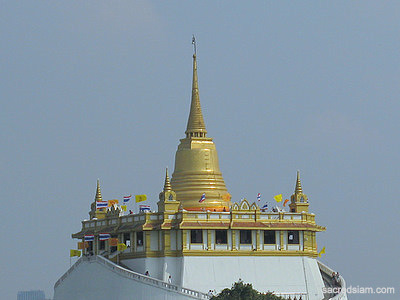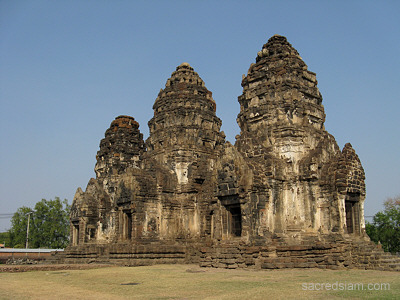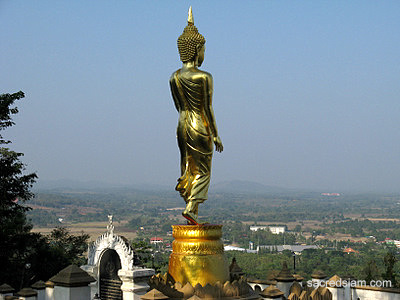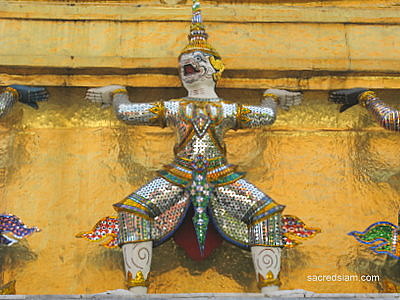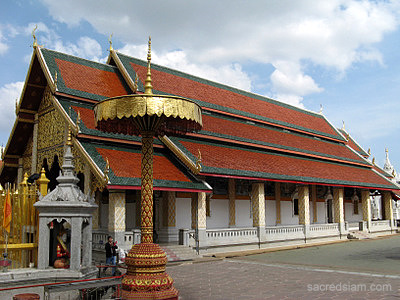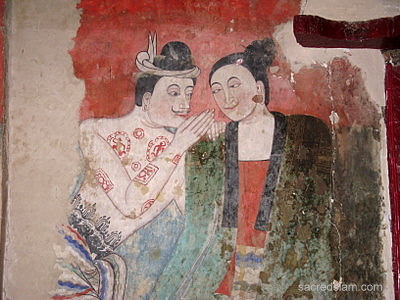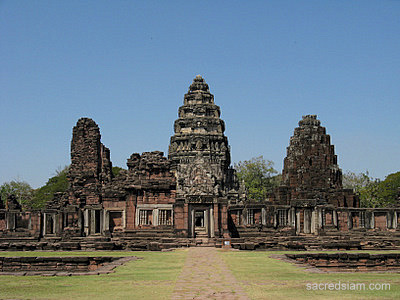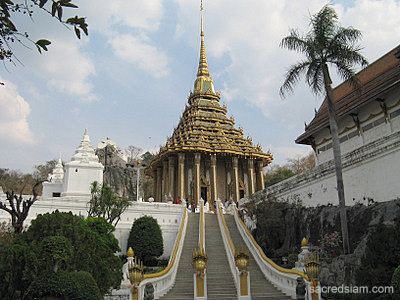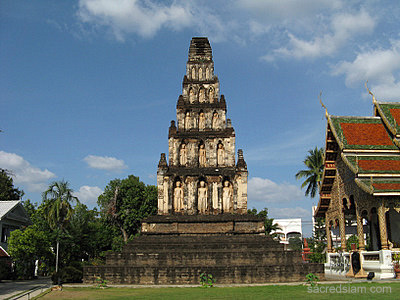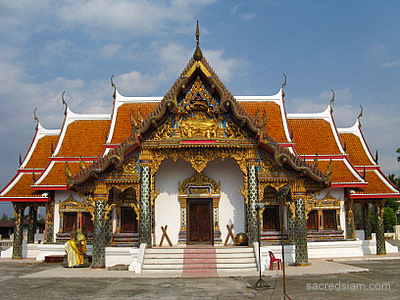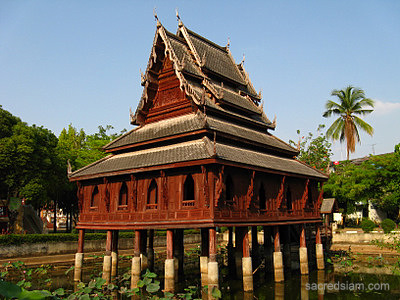Thai temples are one of the kingdom's most attractive features.
Religions and temples
Buddhism has two major schools, or traditions, Southern and Northern. Theravada ("The Doctrine of the Elders"), moved
south from India to Sri Lanka and then to Southeast Asia. Mahayana ("The Greater Vehicle"), moved north through present-day
Afghanistan and along the Silk Road to East Asia, splitting into multiple sects along the way. The majority of Thais today
are Theravadin Buddists whose sacred belief also includes animism and Brahmanism, the precursor to modern Hinduism. So,
while the majority of Thai temples belong to Theravada Buddhism, there are Mahayana Buddhist temples and Taoist temples,
established by Chinese immigrants, a few Hindu temples, and a number of ruined Hindu temples left by the Khmer empire and
subsequently converted for Buddhist use.
In Thailand today there are two main sects, Mahanikai and the smaller but royally founded Thammayut, but no difference
in their temple architecture. There is also a popular new sect called Dhammakaya with a huge temple shaped like a flying saucer.
The term for most temples is wat. A few palace-like structures with multiple spires are known as prasat,
which, in the case of Khmer-style buildings, means a sanctuary for the worship of Hindu deities. The word prang
may be used for a structure which only has one or more Khmer-style spires remaining. Shrines dedicated to one
specific spirit or non-Buddhist deity are known as san.
Regional temple styles
The majority of Thailand's population are ethnic Tai who gradually migrated from Yunnan in southwest China, but they were
not the original inhabitants of what is now Thailand. The Srivijaya empire, based in Sumatra, stretched up the penninsula
from the 7th to the 13th centuries. The Dvaravati kingdom of the Mon people flourished in the central region and parts of Burma until
it came under the influence of the Khmer empire in the 10th century, and was invaded by the Khmer in the first half of the
12th century. Haripunjaya, another Mon kingdom, existed as far north as modern-day Lamphun (Hariphunchai) until the late 13th
century.
The earliest Tai group settled in the central region's Chao Phraya River basin and further south. They came to be
known as the Siamese (syam). Later groups moved into the river valleys in
the mountainous north, establishing small kingdoms, and ultimately the whole mountainous area came to be known as Lanna. Much
of Lanna was populated by the Tai Yuan group, while in the west were Tai Yai (Shan) and in the east Tai Lue. The Lao were
also ethnic Tai, with kingdoms in Luang Prabang and Vientiane.
As the Khmer empire declined in the 13th century, the Sukhothai kingdom was established in the lower north, extending
its power over much of modern-day Thailand, and then was absorbed into the aggressive new kingdom of Ayutthaya, based in
the central plains. The Mon were Theravada Buddhists, the Srivijayans were Mahayana Buddhists, and the Khmer were both Hindu
and Mahayana Buddhists. The Tai came into contact with Theravada Buddhism (as practised today) through the Mon, but were also
exposed to Mahayana and much impressed by the Hindu beliefs of the Khmer.
There are now only a couple of examples of Mon temple architecture. Lanna architecture is characterised by the use of wood
and low buildings, originally with open sides, and sometimes influenced by Burmese styles in the west. Sukhothai had its own
distinctive style, particularly in Buddha images and the bell-shaped chedi (stupa). There are stone Khmer Hindu and Buddhist
sanctuaries all across the northeast and central area, as well as Siamese variations on this stone architecture. After Ayutthaya
was sacked by the Burmese in 1767, the capital was moved to Thonburi and then across the river to Bangkok, where the kings of
the Chakri Dynasty attempted to recreate the glory of Ayutthaya. Over the past century, some Western influence has crept into the
design of Bangkok temples.
Temple buildings
Although there are regional variations, the basic temple layout is an assembly hall (viharn) facing east (the direction
the Buddha faced when he attained enlightenment), with a stupa
(chedi) behind and an ordination hall (ubosot or boht) beside it. The ubosot is usually smaller because it is used mainly for monks'
activities, and it can be recognized by sacred boundary stones (bai sema) outside the building at the eight cardinal and
sub-cardinal points. Beneath the bai sema are buried spherical stones about the size of canon balls known as luk nimit, with
a ninth luk nimit beneath the center of the ubosot or its principal Buddha image. At some temples, the ubosot may also serve
as a viharn.
There may be other small halls called viharn housing sacred images, a Buddha footprint, or a shrine to a former ruler or
well-known hermit in the Indian tradition of rishi. They are known in Thai as reusee or lersi, and are often associated with
the founding of temples. If the ubosot does not contain a famous Buddha image or murals, it may well be closed to the public.
Other halls may be locked to prevent theft of historical artifacts.
The stupa, known as a chedi in Thailand ("pagoda" is the name given to stupas in the Far East), is both a memorial to the Buddha and a reliquary. It also
represents Mount Meru, the mountain at the center of the mythical Hindu and Buddhist cosmos. Chedis vary a lot in
style, from the classic bell shape to a cone or a pyramid. Another type of stupa is the Khmer-influenced stone "corn cob,"
known as a prang.
Some temples have a scripture hall, known as a hor trai, and a few old ones are built on stilts in a pond to keep crawling
insects away from the delicate palm-leaf scriptures.
Outside the main buildings a few temples have a "Hell Garden" with gory depictions of what existence in a hell-realm is
like according to the Three Worlds Cosmology. Here you can expect to see concrete human figures with animals' heads, naked people
forced to climb spiked trees, and people being boiled in a large vat with a variety of demons in attendance.
Temple ornamentation
The most noticeable aspect of temple decoration is the guardians at the doors and windows. At a few famous temples, these
may be the iconic yak, or giants. At others they may be Hindu deities, celestials, benign demons, and a variety of mythical
creatues, especially lions (singh) and serpents (naga). Some temples are covered in pieces of glass in mosaic patterns
that originated with an ancient belief that evil spirits would flee if they saw their own reflection.
Temple murals
Temple murals were originally a way of bringing the teachings of the
Buddha to illiterate lay folk. Traditionally, the west (associated with death) wall of a viharn will feature scenes
of beings in other realms as described in the Thai Buddhist text Traiphum Phra Ruang (Three Worlds Cosmology), the east wall
will feature a mural of the Buddha subduing Mara prior to his enlightenment, and the lower side walls will be covered with scenes
from the Jataka Tales (stories of the Buddha's previous lives) while the upper walls will feature celestials and benign
demons facing the principal Buddha image.
Buddha images and other statuary
All temples have one or more Buddha image in the viharn and the ubosot, the purpose of which is to act as a reminder
of the historical Buddha and his teachings. Lay people will normally pay their respects with an offering of incense, a
candle and flowers. The principal Buddha image in a hall will be placed facing east, the direction the Buddha was facing when
he attained enlightenment.
Some temples try to be a kind of one-stop worship center and have statues of Hindu gods, The Laughing Buddha, Avalokitasvara
(Quan Yin, the Chinese Goddess of Mercy), famous monks, mythical monks, hermits and former rulers in the temple grounds.
Sacred relics
There are about two dozen temples
across the north of Thailand whose chedis are believed to contain relics of the Buddha, according to ancient chronicles. The
names of these temples will contain the words phra that (holy relic) or mahathat (great relic). Although there
are no reliable historical sources to verify the authenticity of these relics, they are highly revered. Other chedis may
contain the relics of a former abbot, revered monk or local ruler.
Pilgrimage temples
Unlike Japanese pilgrimages, which usually consist of a cicuit of temples to be visited in a specific order, a typical
Thai pilgrimage is to one temple with a particularly revered image or relic. The most famous pilgrimage is Wat Phra Phutthabat
in Saraburi province, which contains a Buddha footprint mentioned in ancient chronicles. The most revered Buddha image is the
Emerald Buddha at Wat Phra Kaew in Bangkok, followed by the Wat Phra Si Rattana
Mahathat's Phra Buddha Chinnarat statue in Phitsanulok. Temples with relics of the Buddha (phra that) are highly revered, as
are any images with miraculous origins.
Temple etiquette
Thai monks take a vow of total celibacy, so it is regarded as highly inappropriate and inconsiderate to enter a temple
wearing skimpy clothes. For obvious reasons this applies more to women. Ideally, women should not wear shorts, short skirts,
or have their shoulders bare. A few large temples have lay helpers to enforce these rules but most don't. However, don't
assume that because nobody forces you to dress properly that it is OK not to. It's easy enough to put a sarong and/or shawl in your
bag to wear in temples. Shoes must be taken off in any temple hall and the inner area around a chedi, and be sure not to step
on the raised threshold of any temple doors you walk through. Hats should also be removed
inside temple halls. Don't point your feet at a Buddha image (or anyone near you). Women are not allowed to touch a monk (this
includes sitting next to a monk on a bus), or his robes, and cannot hand anything to him directly. Some northern temples may have
an inner area of a temple hall where women are not allowed to enter.
Photography
Since most temples face east, early morning is the best time for photographs. If the weather is fine, the door of the viharn
may be open, allowing the sun to shine on the principal Buddha image. There are generally no restrictions on photography
inside Theravada Buddhist temples, the hall containing the Emerald Buddha at Bangkok's Wat Phra Kaew being the main exception. If you pose
in front of a Buddha image, do so in a respectful way and with your head below the image. Thais will usually kneel or sit
when posing in front of a Buddha image. Chinese Mahayana Buddhist and Taoist temples, and Hindu temples probably won't allow
photography inside the building.
Temple names
Thai temples often have very long names, sometimes bestowed by a king or local ruler, an abbreviated name and a local
name. The full name is usually derived from Pali and Sanskrit words. Words that appear frequently in temple names are
phra (sacred/holy), maha (great), sri/si (majesty), phra that (holy relic), mahathat
(great relic) and aram (Pali suffix meaning "monastery").
Temple offerings
The most common offerings made to Buddha images are lighted candles, incense and flowers. These can be bought at
stalls around the temple or may be obtained inside the temple in exchange for a donation. Another type of offering is small
squares of gold leaf that are pressed onto Buddha images or
luk nimit before they are buried around a new ordination hall.
Temple fees
Active monasteries with monks in residence are supported by donations from the laity, so every Thai Buddhist will make
a donation when visiting a temple and accrue some merit in return. However, some temples of historical or architectural
importance have abnormally high maintenance fees, are not active, or both. These are the temples that charge an entrance
fee of between 20 and 50 baht. Temples with entrance fees can be found in central Bangkok, Ayutthaya and Sukhothai. At
a few upcountry temples you may be invited to make an offering of candles, incense and lotus flowers to a Buddha image or
relics, and a donation would be expected. Someone will probably show you the correct way to make the offering, which involves
doing three prostrations while kneeling. Thais believe that whatever your religion, you will gain merit from this action.
Annoyances
Outside a few large temples in Bangkok (Wat Pho, Wat Phra Kaew) and Chiang Mai (Wat Chedi Luang, Wat Phra Singh) you may
be approached by well-dressed locals claiming the temple is closed due to a "Buddhist holiday" and suggesting an alternate attraction.
Invariably, this will result in a visit to overpriced gem stores and tailor shops. Approaching strangers in the street is out of character
for Thais and these touts are best ignored. Another notorious scam is the "Bird Lady" who feeds pigeons at the southern end
of Bangkok's Sanam Luang, opposite Wat Phra Kaew. She will hand passing tourists some bird seed - or stuff it in their bags -
encourage them to feed the birds and then loudly demand anything from 200 baht to 2,000 baht for it. If you see her, walk
quickly and purposefully in another direction. She has friends who will back her up in an altercation. Unfortunately,
wandering around the area with a map in your hand attracts scammers like her.
Shoe theft is also a problem at some temples. Whether the thieves would target
larger Western-sized shoes is anyone's guess, but if you are wearing expensive shoes, leave them as near to the temple door as
possible or put them in your backpack before entering. Upountry wats are often home to stray dogs, some of which will bark
or growl at strange faces. If you encounter a growling dog, be very careful. Try to find another entrance or wait until the noise
attracts some help from monks or novices.

